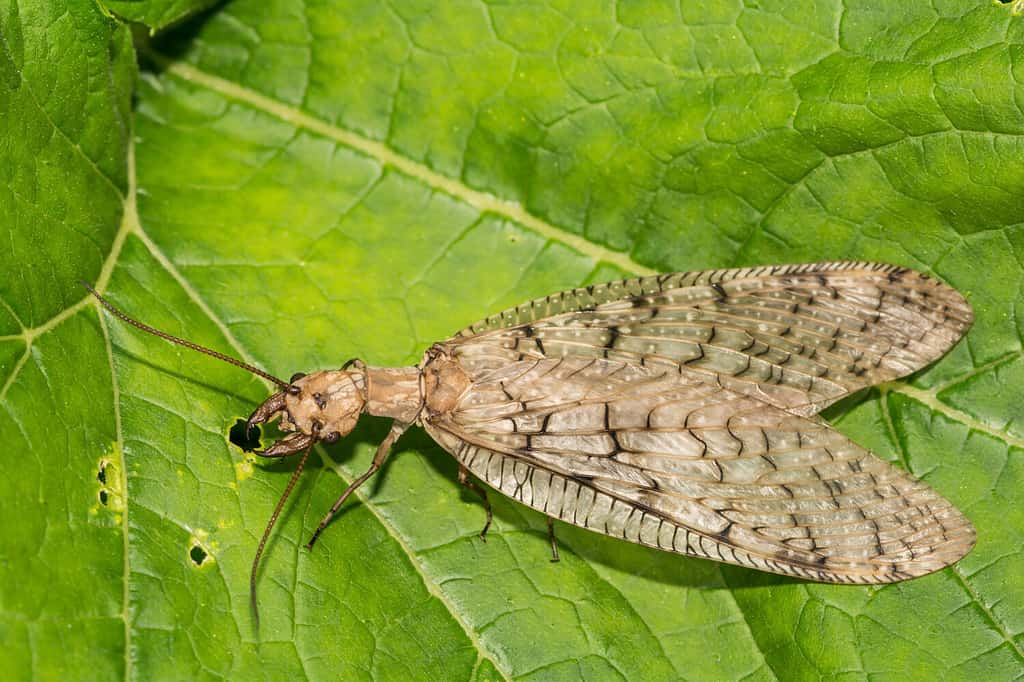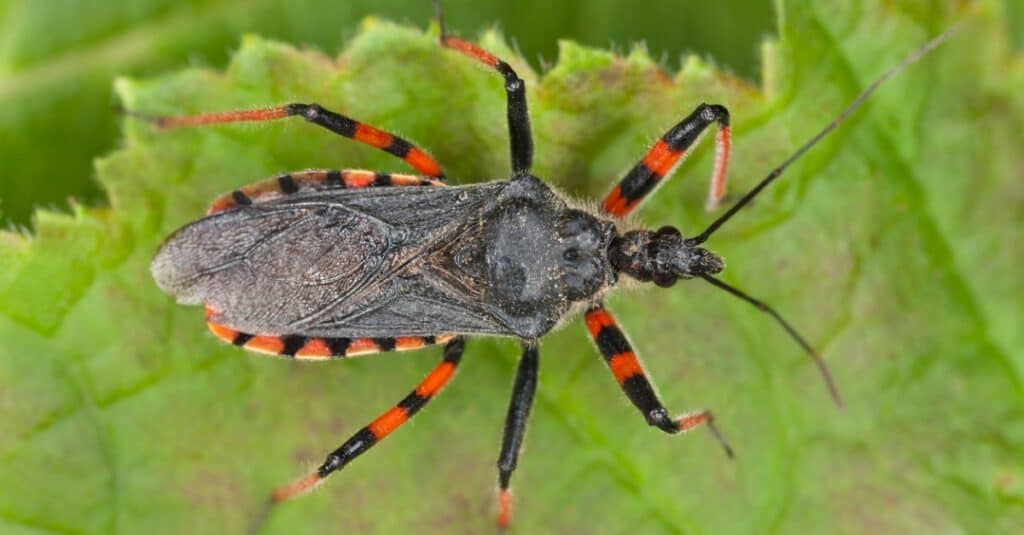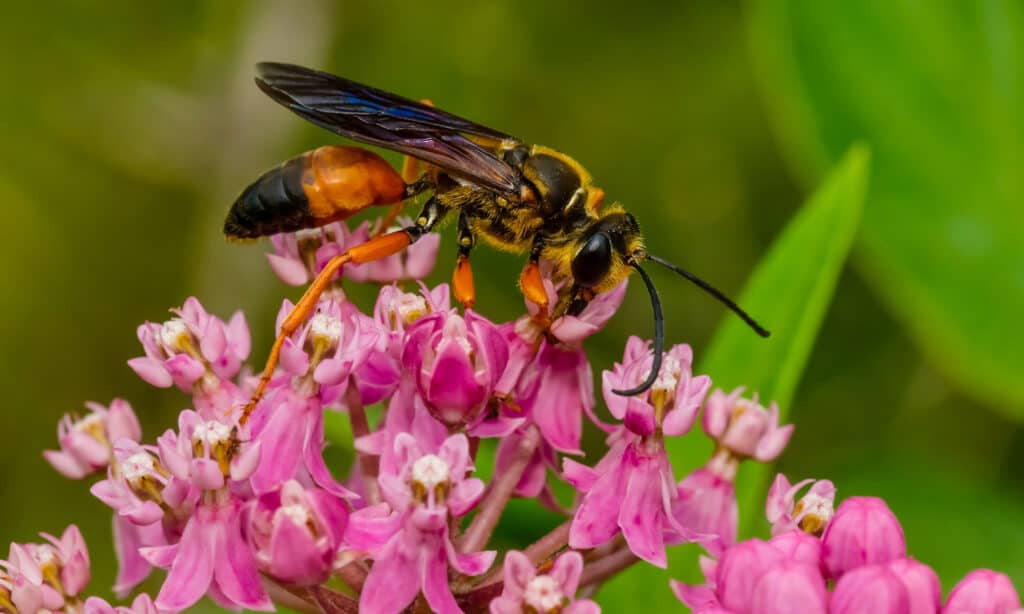Hawaii is a tropical paradise with a wealth of natural beauty, including towering peaks, thick forests, flowing waterways, waterfalls, and more. But among all this lovely flora and fauna, there are scary creatures that move about by jumping, hopping, and flying around Hawaii’s islands.
If you’re relocating to Hawaii or planning a trip there, you might have some concerns about the local creatures and bugs. Which pests live in Hawaii? Is Hawaii home to any deadly flying insects?
1. Dobsonfly

Dobsonflies are easily identifiable due to their unique wings.
©Jay Ondreicka/Shutterstock.com
One of the biggest water insects in the United States is the dobsonfly. Adults are between two and four inches long from the top of their heads to the ends of the wings. Speaking of, their wings rest over the body in a roof-like fashion.
Dobsonflies have a velvety, brownish-gray body. The wings are frequently speckled and have numerous veins. You can safely disregard dobsonflies that you find distant from the river in suspicious places.
Dobsonflies are only marginally dangerous to handle. If treated haphazardly the female with the short, discrete mandibles has the potential to deliver an especially painful bite.
2. Assassin Bug

The Kissing Bug is one of the most common types of assassin bugs.
©Henrik Larsson/Shutterstock.com
The assassin bug has a complicated life cycle. There are more than 7,000 species, each with a unique life cycle and preferred habitat. They are widespread around the world and feed on garden pests. These helpful insects are nocturnal creatures.
They will emerge at night to go in search of food. Although these bugs are great to have around your garden, you don’t want to cross paths with one on your Hawaii vacation. Through the mouthpiece that resembles a syringe, they provide saliva to their victim.
The digestive fluids in saliva circulate throughout the body of the prey, swiftly converting it into a stew of nutrients. Victims can’t flee while being consumed since the venom in the saliva incapacitates their muscles.
Unless they are defending themselves, and their offspring, or are prompted, assassin bugs are not violent against people or pets. Their bites can be very painful and uncomfortable for a short period of time. They may also result in an unpleasant reaction that causes burning and excruciating itching.
3. Eastern Red Velvet Ant

A sting from a Red Velvet Ant is rarely lethal.
©Peter Alexander/iStock via Getty Images
This next flying animal in Hawaii has a strange name. This insect, is in fact, not an ant, but a wasp. The “velvet” in their name refers to the fuzzy appearance of the females, which are without wings and frequently vividly colored, resembling a red and black ant.
Red velvet ants are known as “cow killers” because of their potent sting. Although the sting hurts, the venom is not particularly deadly. Velvet ants seldom sting unless prompted, like the majority of stinging insects. Males have wings and are not venomous.
The majority of red velvet ant stings cause only a small localized reaction, including pain and inflammation. If you’ve been stung, check for a tiny black dot there. If there is one there, gently remove it by rubbing something solid over the region, such as a debit card.
Quick removal of the stinger can lessen the intensity of the sting because it may require the stinger two to three minutes to expel all of its venom. Cleanse the area with warm water and soap after the stinger has been taken out, then apply ice.
The response can be controlled with Benadryl and over-the-counter 1% hydrocortisone ointment. When necessary, look into taking a painkiller.
4. Biting Flies

Biting midges, mosquitoes, sand flies, and black flies are examples of groups or families of insects that bite people and animals as well. They come in a variety of minuscule, even microscopic species, a few of which act as disease vectors whereas others bite and create serious annoyance and health issues.
Sand fly bites are generally highly unpleasant. The majority of insects that bite people feed throughout the late hours of the day. If they are awakened while sleeping, flies may occasionally strike during the day.
The overhanging branches of tropical and subtropical rainforests, dry holes in trees, hollow logs, and palm tree crowns are also good places to avoid because of these critters.
5. Great Golden Digger Wasp

These wasps are often found near flowers, much like bees.
©Paul Reeves Photography/Shutterstock.com
Excellent Golden Digger Wasps act and appear like alien creatures from science fiction films. They render their captives unconscious and transport them to secret, subterranean chambers. The eggs hatch, and the young eat the live prey.
Excellent Golden Digger female wasps are solitary organisms with a biological need to burrow and produce new wasps. These are extremely technical and precise skills. She is a masterpiece of excavation from her mandibles to her back legs, creating side compartments and passageways to house her young.
When leaving to go hunting, she hides in the entryway. She will inject a paralyzing venom into her target, then drag or fly it back with her antennae. If you approach their nest, they frequently linger, although they hardly ever sting.
The females can sting if you attempt to handle them or cause them to feel unsafe.
6. Common Thread-Waisted Wasp

Thread-Waisted Wasp mostly eat caterpillars.
©samray/Shutterstock.com
The parasite wasps known as thread-waisted wasps usually grow to just under an inch long and feed on spiders and bugs. Malaxation, a squeezing or compressing of the throat by the wasp’s pincer-like jaws, and the wasp’s sting frequently cause the host to become numb.
The wasp deposits an egg on top of the host’s body, which is then placed in a mud cell. The host is eaten by the larva when it hatches. They aren’t typically aggressive toward humans. Like other wild animals, they will react if provoked. This tends to happen if people handle the wasp or accidentally step on them.
Summary of Hawaii’s Most Dangerous Flying Animals
- 1. Dobsonfly
- 2. Assassin Bug
- 3. Eastern Red Velvet Ant
- 4. Biting Flies
- 5. Great Golden Digger Wasp
- 6. Common Thread-Waisted Wasp
The photo featured at the top of this post is © Susan Rydberg/Shutterstock.com
Thank you for reading! Have some feedback for us? Contact the AZ Animals editorial team.







